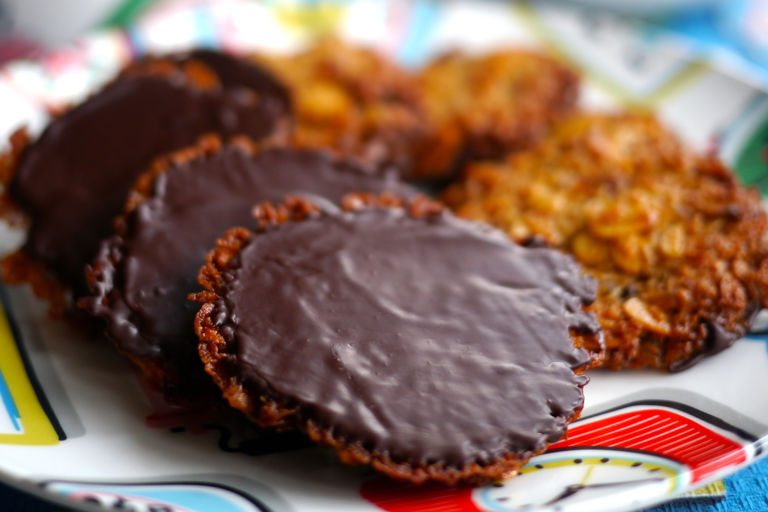Gluten-free Florentines
Victoria's Florentines are deliciously decadent with their glossy tempered chocolate coating and sticky honey caramel, and they're gluten-free, too.
These chewy Italian biscuits are impressively showy, but deceptively easy to make. Perfect for an afternoon lift or as indulgent petits fours served with coffee after dinner. These biscuits work wonderfully with different fruits and nuts to suit all occasions and moods – dried cranberries instead of cherries make a lovely festive change at Christmas or a hint of Simnel spice with extra chocolate chips makes for a wonderfully indulgent Easter treat. Versatile and sophisticated, these innocent-looking treats are highly addictive.
Florentines are relatively easy to make gluten-free as they already contain very little flour. I always include finely chopped stem ginger, as the gently warming spice acts as a delicious foil for the nursery sweetness of the biscuits and the bitterness of the dark chocolate coating.
Florentines should still retain a little chew and not be out and out crunchy: that is part of their charm. They’re not brandy snaps after all. The laciness is found mostly at the edges and, although they should certainly not be bendy, too much of a snap means the Florentines are over-baked.
I personally favour a modern approach to the chocolate decoration. The classic wavy pattern on the back looks rather old-fashioned to my relatively young eyes and I prefer a simple blanket of tempered chocolate. I don’t want to spoil the cleanness of the sheen with the interruption of fork tines. Also, it means you end up with a less heavily coated biscuit, which makes them a little less sickly.
You can be forgiven for assuming that the most intimidating component to these biscuits is the tempered chocolate. Believe me when I say that there are a lot of things in life to be scared of, but tempering chocolate isn’t one of them. Tempering is simply the controlled melting of chocolate to ensure it has an even shine and a lovely snap when it sets. This is most easily achieved by the seeding method.
Simply melt two-thirds of your chopped chocolate in a heatproof bowl over a pan of barely simmering water until it reaches 45˚C. A plastic bowl is always useful for chocolate work, as any leftovers, which have set in the bowl, can be snapped out and reused by pushing the sides of the bowl together. You can also melt the chocolate in the microwave. Once the chocolate has reached 45˚C, gradually add the remaining chocolate and stir until the chocolate cools to 27˚C. At this stage, sit the bowl back on the saucepan of hot water (keep the gas off, the residual heat from it having boiled will be hot enough) and stir and reheat until the chocolate reaches 31˚C. You have just tempered your chocolate. See, that wasn’t too hard, was it?
These are taken from my second book, Deliciously Vintage, but if you want to get a little more adventurous with Florentines, please let me direct you to my third book, Baking Mash-Up, which features a recipe for Florentarts – a mash-up of a Florentine and a chocolate tart.
Ingredients
Metric
Imperial
- 50g of butter
- 100ml of double cream
- 150g of light muscovado sugar
- 2 tbsp of clear runny honey
- 75g of glacé cherries, chopped
- 140g of desiccated coconut
- 150g of flaked almonds
- 50g of stem ginger, finely chopped
- 50g of mixed peel
- 50g of rice flour, sifted (or use plain flour if not gluten-free)
- 200g of dark chocolate drops, or chef's cooking chocolate
- 1 pinch of salt
Method
Get in touch
Please sign in or register to send a comment to Great British Chefs.



